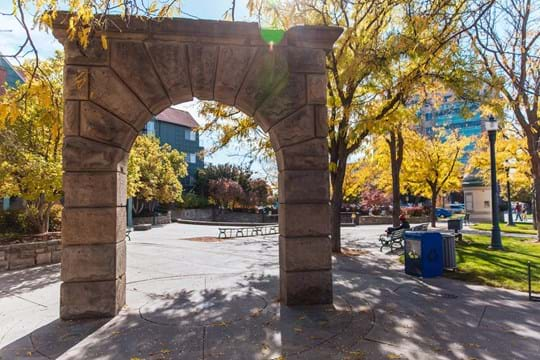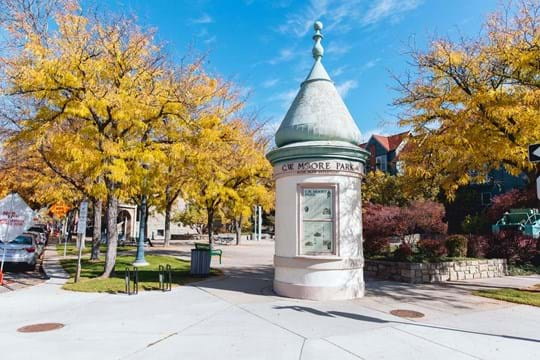Park History
This park lies in an historic area. One half block to the north on Main Street, covered wagons headed west along the Oregon Trail. The canal that runs through the park--the Grove Street Ditch, was constructed in 1866. Large water wheels every fifty to one hundred yards along the canal lifted water to flumes which carried it to many gardens along Main Street.
Grove Street was once Boise’s most prestigious residential area. C.W. Moore built a grand home at Eighth and Grove Street in 1879 (right photo) which became the Delamar Hotel after the Moores moved to a new mansion on Warm Springs Avenue and Walnut Street. The hotel was demolished by Urban Renewal in 1972, but several artifacts, including a bay window, were salvaged by the Idaho Historical Society and are now on display in the Idaho State Historical Museum in Julia Davis Park.
The two lots Moore deeded to the city for a children’s park and playground were not developed until the 1930s when a playground was finally built. In 1956, a World War II barracks was moved to the site to serve as a home for the Idaho Society of Crippled Children and Adults. When the Society moved in 1975, the Boise Jaycees used the building as a community and youth center. The building was removed to make way for the re-establishment of the park, which was dedicated in 1983.
The Famous Donor
Christopher W. Moore arrived in Boise in 1863, the year of the city’s founding. On July 4th of that year, Mayor Pinckney Lugenbeel and an Army company had selected a site near Cottonwood Creek for their new military post named Fort Boise. Three days later, the town itself was organized and the street plan laid out.
C.W. Moore (left) was born in Toronto, Canada in 1835 and educated in Wisconsin. He came to Oregon in 1852 with his family and a large party of pioneers. The emigrants brought along 300 head of cattle and horses, which the sixteen year-old Moore helped drive across the plains.
After a few years of raising, buying, selling and shipping livestock, Moore came to Idaho in 1862 and was soon running stores in Ruby City and Silver City. Moore and his partner, B.M. DuRell offered some limited banking services in their general stores and in 1867, established the First National Bank of Idaho, one of the first chartered in the West.
Through his astute management of the bank over the next half century, Moore contributed much to the growth of Idaho’s business and industry. In 1891, he helped form the Boise Artesian Hot and Cold Water Company and heated his own Warm Springs Avenue home with natural hot water – the earliest such use in the United States.
Moore’s sense of civic responsibility was of a high order and he gave generously and inconspicuously to charity for many years. At his death, The Idaho Daily Statesman wrote of him, “If he heard of cases of need, it was his custom to render aid before his assistance was asked.” Among Moore’s many such contributions is this park, deeded to the city in 1916, the year of his death.


